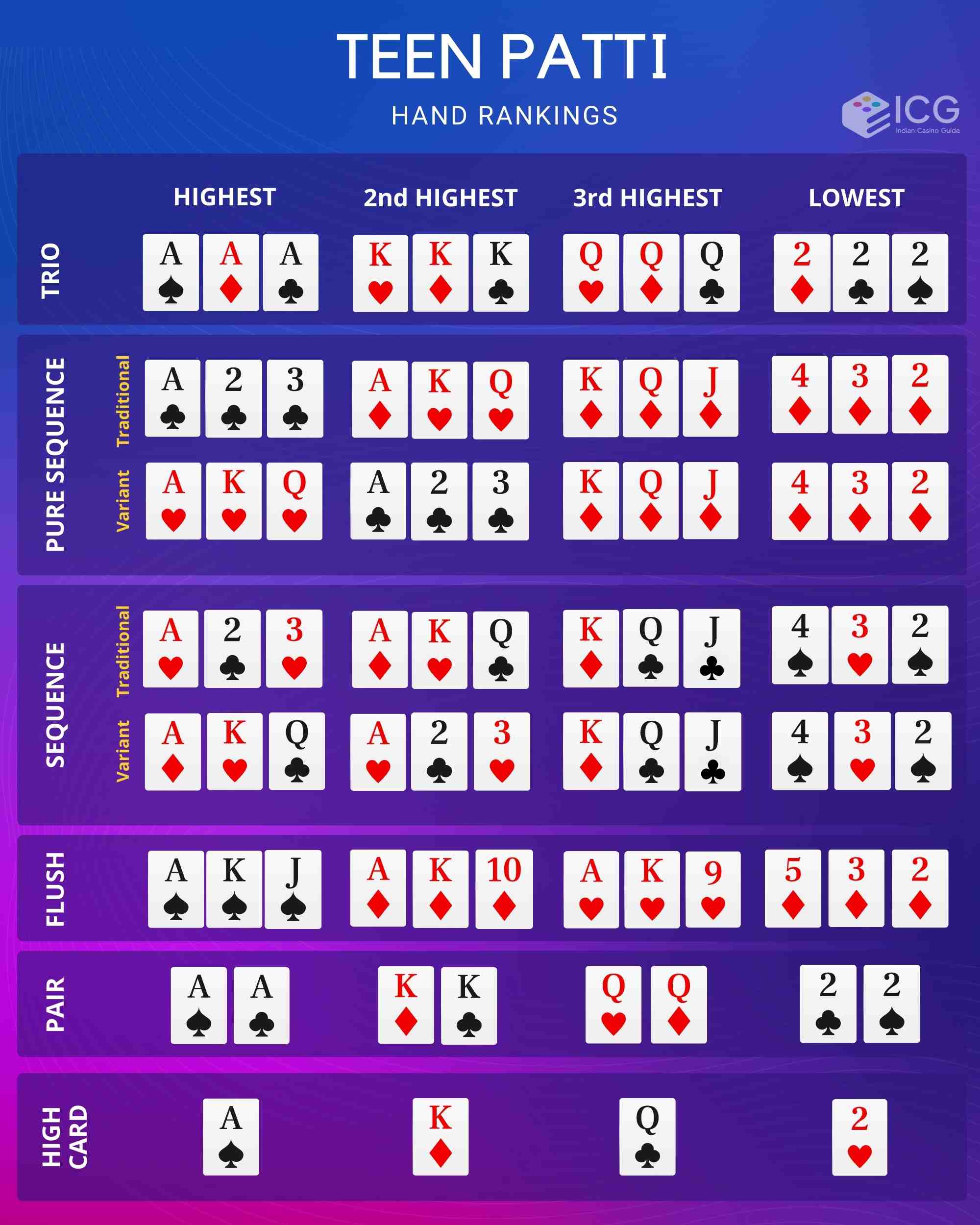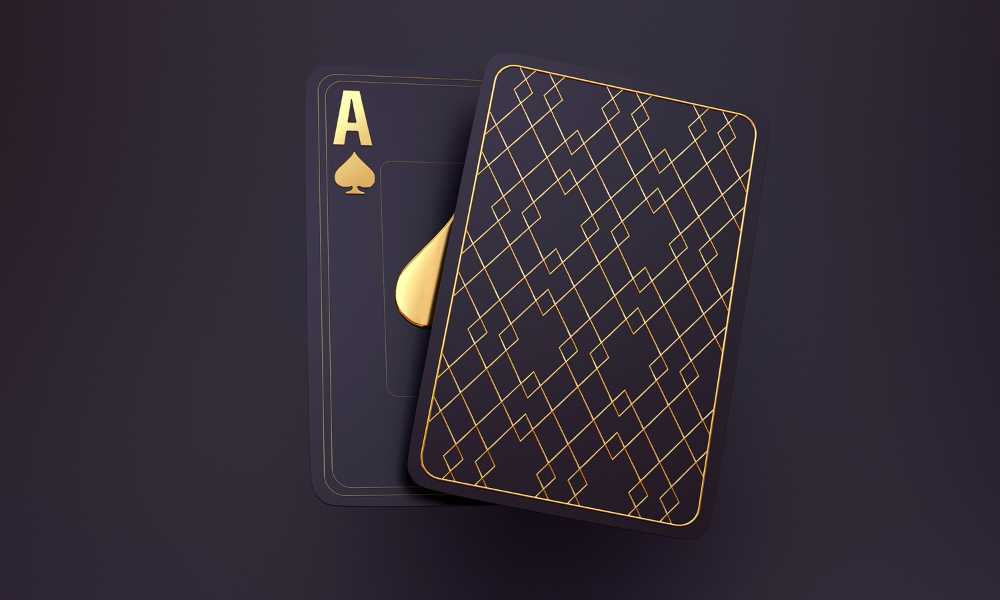The 6 Teen Patti Sequences You Need to Know
In the game of Teen Patti, players strive to achieve the best possible three-card hand. Six different sequences determine the hand rankings.
Let’s explore each of these sequences and their probabilities in detail:
| Sequence | Meaning | Explanation |
| 1. Trail or Set | Three cards of the same rank. For example, three Aces. | A “Trail” or “Set” is the highest ranking hand in Teen Patti. It has three cards of the same rank, such as three Aces or three Kings. The suit of the cards doesn’t matter in this case. If two players have Trails, the one with the higher-ranking cards wins. For example, a Trail of Aces would beat a Trail of Kings. |
| 2. Pure Sequence or Straight Flush | Three succeeding cards of the same suit. For example, 7, 8, and 9 of hearts. | The “Pure Sequence” is the second-highest-ranking hand. It comprises three succeeding cards of the same suit. For example, 7 of hearts, 8 of hearts, and 9 of hearts would form a Pure Sequence. If multiple players have Pure Sequences, the player with the highest top card wins. In the case of a tie, the second-highest card is considered, and so on. |
| 3. Sequence | Three succeeding cards of mixed suits. For example, 5 of spades, 6 of hearts, and 7 of clubs.. | The “Sequence” is a three-card combination where the cards are in consecutive order but not in the same suit. For instance, if you have 5 of spades, 6 of hearts, and 7 of clubs, you have a Sequence. Again, the player with the highest-ranking top card wins in case of a tie. |
| 4. Color or Flush | Three cards of the same suit, not in sequence. | The “Color” is a hand where all three cards are in the same suit but not in sequence. For example, if you have 4 of diamonds, 8 of diamonds, and Queen of diamonds, you have a Color. If multiple players have Colors, the player with the highest-ranking card wins. If there’s still a tie, the second-highest card is compared, and so on. |
| 5. Pair | Two cards of the same rank and one unmatched card. | The “Pair” consists of 2 cards of similar rank and one unmatched card. For instance, if you have a pair of Jacks and an unmatched 5, you have a Pair. If two players have Pairs, the player with the higher-ranking pair wins. If both the players have the same pair, the highest unmatched card (known as the “kicker”) is compared. |
| 6. High Card | None of the above combinations. The highest card in this case determines the hand’s value. | If none of the above sequences are achieved, the hand is evaluated based on the highest card. The highest card in the hand is considered. If two players have the same highest card, the second-highest card is compared, and so on, until a winner is determined. |
Remember that Teen Patti is not only about the hand rankings but also about strategy, bluffing, and betting. Players aim to read their opponents, make informed decisions about whether to fold, bet, or raise, and create a favorable outcome using a combination of skill and luck.
Each teen patti sequence has its own level of rarity and strategic value, and mastering the game involves not only knowing these sequences well enough but also gauging the odds and making wise decisions based on:
- The cards in hand, and
- The ones visible on the table
Teen Patti Sequence Probabilities
Understanding the probabilities of different Teen Patti sequences is crucial for making informed decisions during the game.
Here’s an overview of the probabilities associated with each of the six Teen Patti sequences:
| Sequence | Explanation | Probability |
| 1. Trail or Set | The probability of getting a Trail or Set is relatively low since you need 3 cards of the same rank out of a 52-card deck.
There are four possible ways to choose the rank (Aces, Kings, Queens, etc.) and then four ways to select one card from each suit. So, the total number of possible Trails is 4 x 4 = 16. |
|
| 2. Pure Sequence or Straight Flush | Achieving a Pure Sequence is slightly more likely than a Trail, but it’s still relatively rare. You need three continuous cards of the same suit out of a 52-card deck.
There are 4 suits and 10 possible runs of three consecutive cards within each suit (e.g., A-2-3, 5-6-7, etc.). |
|
| 3. Sequence | A Sequence is more common than a Pure Sequence but still less likely than the next three hands. You need three consecutive cards of different suits.
There are 4 ways to choose the highest card in the sequence, and each choice has 3 x 3 = 9 possible arrangements of suits. |
|
| 4. Color or Flush | Achieving a Color is more probable than the previous hands. You need three cards of the same suit but not in sequence.
There are 4 ways to choose the suit, and then you need to choose 3 cards from that suit out of the 13 cards. |
|
| 5. Pair | Getting a Pair is more likely than the previous hands. You need 2 cards of the same rank and one unmatched card.
There are 13 possible ranks to choose from. Once you choose a rank, you then need to select 2 suits out of 4. |
|
| 6. High Card | The High Card hand is the most common outcome in Teen Patti. It occurs when none of the above sequences are achieved.
You need to consider all 52 cards since there are no restrictions on the cards’ ranks or suits. |
|
These probabilities highlight the rarity of certain Teen Patti sequences and can guide your decision-making during the game. While understanding the odds can be helpful, Teen Patti also involves strategic elements such as reading opponents, bluffing, and considering the betting dynamics.
The Highest and Lowest Values of the Teen Patti Sequence
| Sequence | Highest Value | Lowest Value |
| Trail or Three of a Kind | Three Aces (A-A-A) | Three Twos (2-2-2) |
| Pure Sequence | Ace-2-3 (A-2-3) | 4-3-2 |
| Straight or Sequence | Ace-2-3 (A-2-3) | 4-3-2 |
| Colour or Flush | Ace-King-Jack | 5-3-2 |
| Pair | Pair of Aces | Pair of Twos |
| High Card | Ace | 2 |

Please note that the “High Card” row represents individual card values when no specific sequence is formed. The values mentioned in the table represent the rank of cards from highest to lowest within each sequence type.
Teen Patti Sequence Payouts
In Teen Patti, payouts refer to the amounts that players win or lose based on the outcome of their hands and the bets they placed during the game. The payouts are determined by the hand rankings and the bets made in the game.
Let’s delve into the details of Teen Patti sequence payouts:
| Sequence Type | Explanation | Payout Ratio |
| Trail or Set | Trails or Sets have the highest rank and typically offer the highest payout in the game. The payout ratio for Trails can vary depending on the house rules or the betting structure. | 1:1 or 1:2, meaning you win an equal amount to your bet or double your bet |
| Pure Sequence, Sequence, Color | Pure Sequences, Sequences, and Colors are mid-ranking hands and offer moderate payouts. Similar to Trails, the payout ratios for these hands can vary. | Often set around 1:1 or 1:1.5 |
| Pair | Pairs are relatively common hands and offer lower payouts than higher-ranking hands. | Usually range from 1:1 to 1:0.5 |
| High card | High Card hands are the lowest-ranking hands and offer the lowest payouts. | Typically, around 1:0.5 |
How to Make the Highest Teen Patti Sequence
Creating the highest-ranking Teen Patti sequence involves having a Trail or Set, which is the most valuable hand in the game. A Trail consists of three cards of the same rank.
For instance, three Aces (A-A-A), three Kings (K-K-K), or three Queens (Q-Q-Q).
Here’s a step-by-step guide on how to create a Teen Patti winning sequence:
Creating the highest Teen Patti sequence, a Trail is largely a matter of luck due to the random distribution of cards. The game’s excitement comes from the interplay of strategy, betting, and the element of chance. While aiming for the highest sequence can be thrilling, it’s essential to enjoy the game’s social and competitive aspects while respecting the rules and spirit of the game.
Essential Tips to Keep in Mind
If you are unsure of your cards, it is always better to pack them in to avoid significant losses. Always play with only the money you can afford to lose, never higher. Be sure to game responsibly. These tips can help you play better and win more if used effectively but know that your opponents also have a good grasp on the know-how of the game.





No Comment! Be the first one.